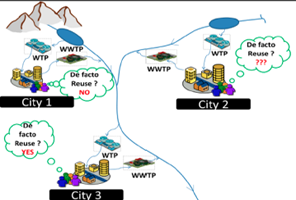September 24, 2013
Assessment of De Facto Wastewater Reuse across the U.S.: Trends between 1980 and 2008
Published
August 19, 2013 in Environmental Science and Technology, DOI: 10.1021/es402792s
Authors
Jacelyn Rice, School of Sustainable Engineering and the Built Environment and DCDC Graduate Research Assistant, ASU
Amber Wutich, School of Human Evolution and Social Change, ASU
Paul Westerhoff, School of Sustainable Engineering and the Built Environment, ASU
Abstract
 De facto wastewater reuse is the incidental presence of treated wastewater in a water supply source. In 1980 the EPA identified drinking water treatment plants (DWTPs) impacted by upstream wastewater treatment plant (WWTP) discharges and found the top 25 most impacted DWTPs contained between 2% and 16% wastewater discharges from upstream locations (i.e., de facto reuse) under average streamflow conditions. This study is the first to provide an update to the 1980 EPA analysis. An ArcGIS model of DWTPs and WWTPs across the U.S. was created to quantify de facto reuse for the top 25 cities in the 1980 EPA study. From 1980 to 2008, de facto reuse increased for 17 of the 25 DWTPs, as municipal flows upstream of the sites increased by 68%. Under low streamflow conditions, de facto reuse in DWTP supplies ranged from 7% to 100%, illustrating the importance of wastewater in sustainable water supplies. Case studies were performed on four cities to analyze the reasons for changes in de facto reuse over time. Three of the four sites have greater than 20% treated wastewater effluent within their drinking water source for streamflow less than the 25th percentile historic flow.
De facto wastewater reuse is the incidental presence of treated wastewater in a water supply source. In 1980 the EPA identified drinking water treatment plants (DWTPs) impacted by upstream wastewater treatment plant (WWTP) discharges and found the top 25 most impacted DWTPs contained between 2% and 16% wastewater discharges from upstream locations (i.e., de facto reuse) under average streamflow conditions. This study is the first to provide an update to the 1980 EPA analysis. An ArcGIS model of DWTPs and WWTPs across the U.S. was created to quantify de facto reuse for the top 25 cities in the 1980 EPA study. From 1980 to 2008, de facto reuse increased for 17 of the 25 DWTPs, as municipal flows upstream of the sites increased by 68%. Under low streamflow conditions, de facto reuse in DWTP supplies ranged from 7% to 100%, illustrating the importance of wastewater in sustainable water supplies. Case studies were performed on four cities to analyze the reasons for changes in de facto reuse over time. Three of the four sites have greater than 20% treated wastewater effluent within their drinking water source for streamflow less than the 25th percentile historic flow.
Read the entire article at Environmental Science and Technology.

